Going Off Grid with Your Caravan
Does Caravan's DIY guru, Rod Farrendon, have what it takes to survive without hook-up? An apprehensive Mrs F certainly hopes so.
The date was set, we were off to a tiny campsite with no facilities! At last, I was going to get the chance to try out the solar-panel system I had painstakingly researched and installed.
I was excited but my long-suffering wife, Kim, was apprehensive. We had decided not to go far but to visit somewhere different to our usual stomping ground, the south coast.
I remembered day trips in my youth with my big brother, fishing at some spectacular locations. A plan was formed, for a week in September.
To the Gower
There is a little gem in south Wales that juts out into the Bristol Channel, just west of Swansea; it's the Gower Peninsula.
Gower is, well, I was going to say like a miniature Devon and Cornwall, but it's not a copy, it has a uniqueness and diversity all its own. There are 4000 acres of salt marshes on the north side, renowned for delicious lamb – definitely on our menu.
The three-mile long, sandy Rhossili beach that sweeps out to Gower's southwestern tip, is known as the worm's head and is only accessible at low tide (I spent the night out in the open there once. Big brother's idea, I can't recommend it!).
Then, there are the heathland and moors of the interior, including Cefn Bryn (ridge hill) with Arthur's Stone (a Neolithic burial site). The views from here are stunning.
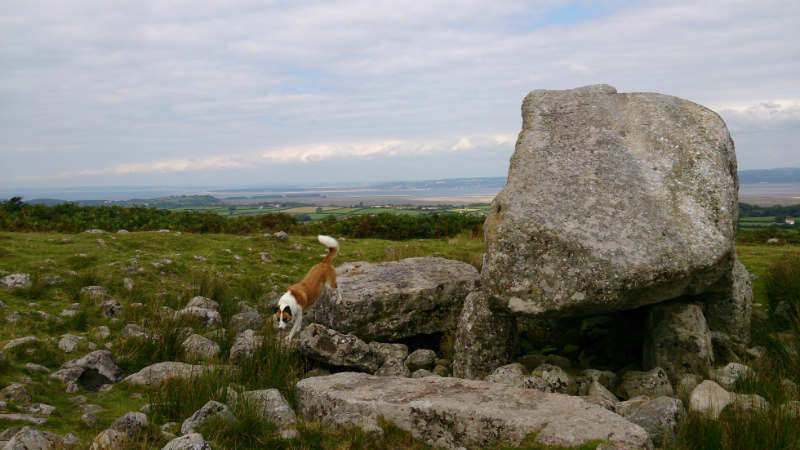
Above: Arthur’s Stone, a Neolithic burial site at Cefn Bryn. Hope Cally didn’t find any bones!
As for the south side, starting from the eastern corner, you have Mumbles, with its promenade and pier, café and amusements arcade. Then, travel through wooded valleys and sometimes narrow lanes, which are no problem to navigate and give a feeling of the old days, not too commercialised.
Good Sites
There are beaches and coves, a different one for each day of the week and some to spare. Our favourite is Three Cliffs Bay, a bit of a hike down and then back up (good shoes help), but well worth it, for what some consider the prettiest bay in the UK.
There are numerous non-electric hook-up, five-caravan sites on Gower, ranging in price from £4.50 to £8 a night. Even touring sites like Three Cliffs Bay will give a discount for non-EHU pitches.
We use Google Maps to check some of them out. You simply log on to google.co.uk/maps, pop in a postcode or address, then, when the map appears, 'grab' the little yellow-man icon with your cursor, and drop him on the map to check out Street View – a seamless photographic view of the area where you can see the lie of the land.
Good Views Means Better Daylight
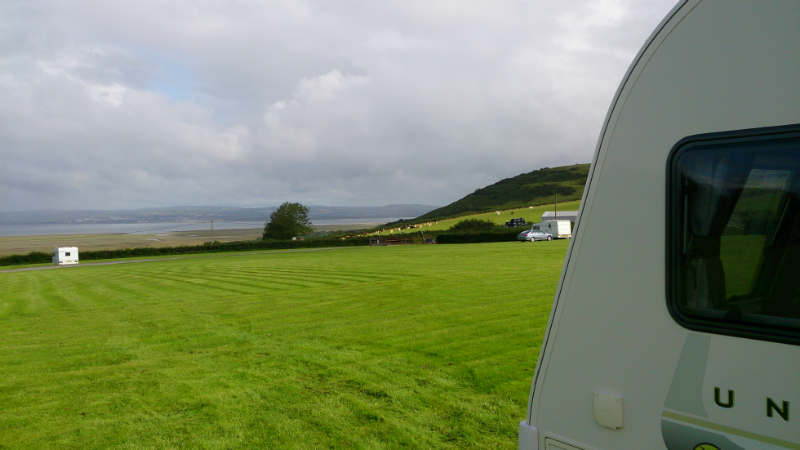
Check Street View for shading by nearby woods or hills, and the direction of sun across the site (particularly important for solar-vanners) and, of course, the views. If you have decent views, then there's a good chance you're not in a valley or surrounded by trees, so you'll have access to lots of daylight – yes, I did say daylight, not sunlight.
This is the UK, after all. Sunlight will make the solar panel more efficient but photovoltaic panels will produce electricity in any daylight.
We had chosen well, and were made welcome at Stavel Newydd Caravan Club CL site. It is superb and the water, waste disposal and recycling areas are as good as it gets. Within walking distance there is a garage, with a shop selling everything from your daily newspaper to bottled gas, and a local pub, The Dolphin, that serves food.
Just up the road, in the next village, is The Greyhound pub, which has good food, too. Both of these hostelries serve the local salt-marsh lamb and are also dog friendly, great as where we go, so does our Cally.
Then, just a little further on is Weobley Castle and a farm shop. Now, this is a must-do visit, because this is where you can buy that succulent salt-marsh lamb for the barbecue.
This, then, is the location for our first off-grid adventure.
Ready, Steady, Check
Before we set off, I carried out the usual checks: tyre pressure, lights and wheel-stud torques.
I also checked both gas bottle gauges, which read full (we'll come back to that later) and the battery readings – the main battery was 13.5V, and the auxiliary one 13.4V. Both full. This, of course, was while they were connected to the solar panel system.
This week away was to be a trial of the system and a steep learning curve for both of us, so we decided to adopt a well-known saying, 'Every little helps', especially when it came to conserving or generating electricity.
On that basis, I made sure my cordless electric shaver was fully charged, and put the USB chargers for the phones and the camera in the car, to use while driving around sightseeing.
It's a good idea to charge anything that can be charged using a 12V socket in the car, when out and about but, I must admit, I went a bit over the top, as the PV solar system on the caravan performed superbly.
And the fact that we had a week of mostly glorious bright days, meant the batteries were fully charged come sundown.
What to Drop
Items to be ditched for the trip included the gas barbecue, low wattage 240V kettle, 240V vacuum cleaner and, heaven forbid, the hair dryer (don't see the problem, myself).
The gas barbecue was to be replaced by an efficient and easy-to-clean charcoal one. This was because we'd need to conserve our gas as much as possible, as it was now our main source of heat, hot water and, of course, power to run the fridge.
Obviously, anything that used 240V was surplus to requirements. So, into the caravan went the whistling kettle and the 12V vacuum cleaner that we'd won in a raffle two years before (it proved so good that Kim says I can keep the old 240V one in the garage for cleaning the cars!).
And, no, I haven't forgotten, Kim has been off and purchased a gas-canister-powered hair styler, which she is pleased with. Phew!
Gas Efficiency
Once we got to the site, it felt a bit strange. The caravan was sited and level, the awning inflated and pegged down (great bit of kit), on-board tank full, Aquaroll refilled, toilet taken care of, but no orange ribbon snaking through the grass to the nearest EHU bollard.
-w800.jpg)
We had switched the fridge from car to gas, but it wasn't long before we realised, even on half setting, that it was cold, so we turned it down to about the 40% setting. We noticed throughout our trial week that the gas operation of services seemed to be far more efficient than when using electric hook-up.
Then again, caravans evolved using gas long before someone decided to chuck a battery and 240Vs into them.
The hot water was piping hot, too. I set the Alde heating at 17.5 degrees, as I believe having the heating on a constant low setting is more economical than whacking up the temperature to try and heat a cold caravan. It worked well on sunny days, as the caravan acted as its own solar panel, and the heating only kicked in at night.
On day three, when I checked the gas, it had dropped to about 35% – higher consumption than I was expecting. Then Kim reminded me that we had purchased the bottles before our summer holidays, and used gas for cooking on some days. So, even though the gauge had read full on departure, I reckoned later that about 2kg had already been used.
Twenty-four hours on, the gauge was showing empty, but the fridge and central heating were still on… and they stayed on! The kettle was boiled many times and several showers were had, for a further 36 hours. Maybe it was a faulty gauge? I vowed that I would only use them as a guide in the future.
Gas by Weight
I searched forums on the web for more accurate measures, but they all seem to have knockers and praisers, so I'm going down the route that if the gas is sold by weight then I'm going to gauge my usage by weight. I have a plan.
Not wanting to be up in the night freezing, I changed over to the full bottle last thing before bed, and then back to the empty one in the morning. I reckon a manual changeover valve might be a good idea.
Don't worry about running out of gas, just make sure it is at your convenience, use it all up: 'every little helps'! If you are out, an unopened fridge should be fine for an hour or two. The appliances using gas have safety cut-out features, they will also let you know if the supply runs out: the Alde system will start flashing and the fridge readout will tell me – out of the green means out of gas.
Benefits of Propane
I like to have two bottles of gas, for the simple reason that, if one runs out, you have another to hand. I prefer to use propane as there are no issues in winter – it has a low vaporising temperature of about -44°C, compared to butane's -1°C, so will continue to work in freezing weather.
This is just as well, as I also have to use CalorLite gas bottles. I have an auxiliary battery in the front-side locker and need to keep the noseweight at just under 100kg. If I didn't have such restrictions, I might opt for a 13kg bottle of propane and a standby 3.9kg bottle – full weight of both is about 38kg.
From a cost view, this is the more sensible option: two 6kg Lite refills deliver 12 kg of gas for £46. One 13kg refill costs about £27 – a saving of around £20!
When we returned home, I weighed the bottle we had used for a single day and calculated we'd consume roughly 4.5kg of gas in a week off-gridding. Probably double for a week in winter.
Now, we must also bear in mind that these calculations do not account for the fact that we would still be using gas when connected to EHU, so the 'extra' gas consumption' for off-gridding isn't as high as it first seems.
As we all differ in the way we use energy, it's a case of trial and error. Just make sure you have that full second bottle to hand.
More energy-saving tips
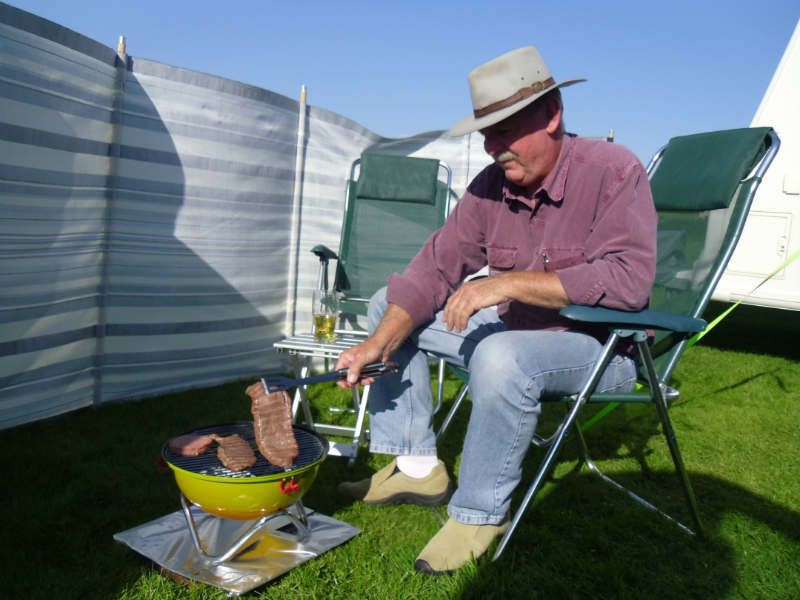
Save gas by barbecuing more often – even in winter it can be fun. Well, it was for the girls when my mate and I did just that in Yorkshire once – they were in stitches, inside a nice, warm van.
While we've been on Gower we have had some great barbecues: rump steak, side salad, salad potatoes and coleslaw one day, then wonderful salt-marsh lamb steaks, jacket potatoes, cooked mushrooms and tomatoes, all done on the barbecue and healthy eating. Oh... and, of course, all washed down by a nice gas-powered fridge-chilled bottle of Pinot.
A tip from Kim, if you're using the oven to cook meat, use the same heat to cook veg and potatoes. Wrap jacket potatoes in foil and pop some chopped veg in a roasting bag – it makes a great ratatouille and it saves on washing up.
Another tip from Kim, and I think her favourite – with the money saved going off-grid, eat out a little more often, This does save on the washing up!
Keep the on-board tank topped up, the warmth inside the van will go some way to warming the water, so, when hot water is needed, the boiler is not heating near-freezing water from outside, using more gas energy. It also means you have a supply if temperatures drop and your Aquaroll freezes overnight.
If you feel the need to vent the caravan a little in the winter, don't open a skylight, slightly open a side window instead. We all know heat rises; open the roof and, whoosh, it's gone.
Solar Power
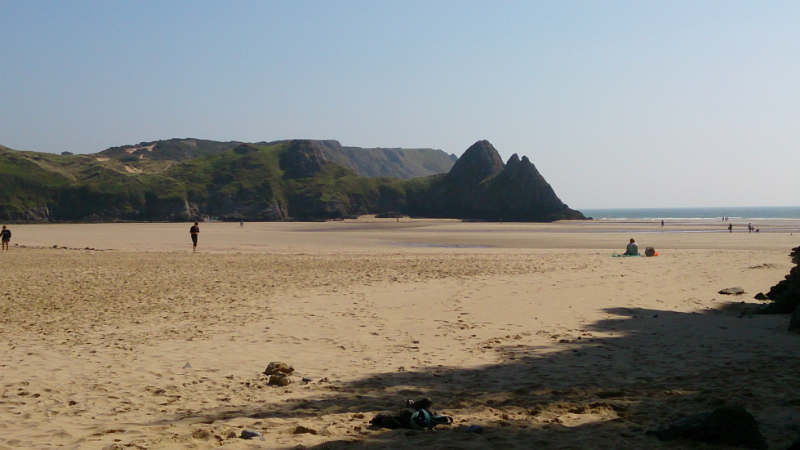
Now to the solar power. I noted readings of up to 4.9 amps and, even on the one dreary overcast day, we got 2 amps, but I was not going to meter watch, we were on holiday and had sights to see.
I did, however, check the battery voltage nightly at lights out; 12.6V and 12.5V were the norm, that's about 25% of the battery used. If it had gone down as low as 12.2V, with about 25% left, I would have switched over to auxiliary battery power. We did not skimp on the TV, watching, maybe, four hours a night. But, we did develop some tricks to saving battery power.
Kim commented, after taking a shower in the afternoon, that the water pressure seemed a little better than the night before. Of course it did! During daytime, the battery was full and the solar panel was providing a boost.
So, doing high-energy consumers, like showering and vacuuming, during the day will save battery power. It's easy in summer, but a bit of planning is required when the days are short.
We keep a dispenser of sanitising gel in the bathroom, for washing hands. This not only saves on electricity (the pump), but water as well: 'every little helps'.
Make use of LED lights
We use a stick-on PIR LED light in the bathroom for middle-of-the-night visits. I haven't changed the batteries for three years. It's a great energy saver, and there are no dazzling lights when you're half asleep.
I have also changed every bulb in the caravan to LED. They are cheap to buy now and getting cheaper. Some lighting circuits, like most caravan bathrooms, have several lights on them, but the centre, ceiling light often has a switch, too. Turn it off! Kim says the darker it is, the better I look!
Preserving Power
I have heard mention of turning off the RCDs to preserve power, especially at night. I'm not sure how effective this is, although I do always turn off the TV signal booster and the power to the motor mover to prevent any small potential drains on the battery.
I'd advise leaving the 12V master switch on at night, especially if you have children in the caravan. In an emergency, or even just a child having a bad dream, you'd need to flick on a light. We don't turn our master switch off, and have had no problems with battery drainage.
Back to the motor mover. Don't use it when off-gridding, as it is a big drain on the battery. Hone your manoeuvring skills with the car. You'll be in a field with plenty of room – and nobody's watching. Honest! Likewise, auto-levellers will devour your battery power.
I toyed with the idea of fitting an inverter, but they are such a big drain on the battery that I didn't. Leisure batteries are deep-cycle ones, designed to release energy steadily, over long periods of time.
Regular use of an inverter may damage and shorten the life of the battery. If you have a real need for 240V power when off grid, consider having an inverter fitted to the towcar – its battery is designed to take a sudden hit – and then use a short extension lead into the van.
Both of my batteries are 110 Ampere-hours. I think 'bigger is better', and they do last longer, but they also take longer to charge.
After our first week's learning curve, and not having needed to switch to the auxiliary battery, I might reduce it to, say, 60Ah, which would be fine for any emergencies and help towards reducing the caravan nose weight.
Green Caravanning with Solar Panels
Touring doesn't get any greener than solar-powered caravanning.
A briefcase-type photovoltaic solar panel is a great way to start. These are fully self-contained and simply connect to the battery. But, you have to keep them facing the sun (turn it towards tomorrow's sunrise, once the sun has gone down), and you have to secure it against theft.
With a roof-mounted solar panel, you should never have to worry about arriving at storage and finding your battery flat. A good controller will keep your battery in tip-top condition, plus your alarm/tracker will always have a power supply… it will even be charging when you're on the move.
Compromises? It does not directly face the sun all the time, so it might need to be of a higher wattage to gain the same output. Also, should you sell your van, the panel will go with it!
Solar panels are completely silent. Total peace and quiet in the countryside. Perfect.
Off-Grid savings
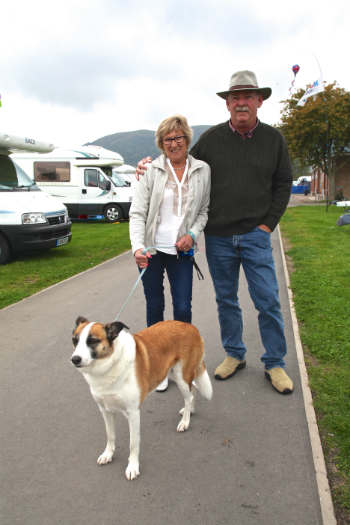
Last, but certainly not least, let's look at what you can save by going off-grid.
A week in September at an off-grid site can cost as little as £35. Compare with a typical club site at £133, and a local commercial site at £182, and you can see the huge savings you can achieve when you don't have electric hook-up.
Another good example of off-grid frugality was our two-week summer holiday in Dorset. We stayed on a five-caravan-only site with EHU and lovely views. It cost £196. We checked out a site two miles away in a field with three acres of adjacent woodland, no EHU, and stunning views. That cost £70. More often than not, you'll find small, non-EHU sites, CSs and CLs have better views than bigger sites, too.
Of course, there is more than just EHU to consider. Sites don't just offer shower and toilet facilities; there's the clubhouse with entertainment, restaurants and swimming pools, all kinds of other services and entertainments to attract customers.
Going off-grid will not be for everyone, but even a small solar panel will keep your caravan powered up and provide other benefits, including keeping your battery charged when the van is in storage.
We all differ in what we want from a caravan holiday, but one thing's for sure – we all love caravanning. Off-grid caravanning doesn't mean roughing it. Just ask Mrs F!








Recent Updates
Caravan bike racks: a complete guide
Exploring the beautiful surroundings while on a caravan trip is undeniably one of the greatest joys of the adventure. While you have options like ...
Caravan chassis: all you need to know
A caravan chassis is a skeletal frame that runs from front to back, supporting the body and linking the ...
Caravan cooking recipes
Caravan cookery inspirational ideas. No need to stress out in the kitchen with these quick and easy ...
Caravan satellite dish guide: everything you need to know
Few holiday types can rival the escapism of the humble caravan, but we all love to sit back and relax in ...
Caravan insurance: all you need to know
Navigating the world of caravan insurance can feel like a daunting task. Fear not, as this comprehensive ...
Caravan tyres: everything you need to know
In this tyre guide, we'll explain everything you need to know about looking after your caravan tyres and ...
Caravan solar panels: all you need to know
Whether you dream of roaming off-grid or just fancy reducing your carbon footprint, fitting solar panels to ...
Caravanning with dogs: all you need to know
Explore caravanning with dogs with our comprehensive guide covering tips on accessories for dogs, ...
How to set up a caravan: all you need to know
Setting up your caravan on a campsite pitch is just a sequence of actions. They’re second nature to ...
Caravan showers: all you need to know
In this guide, we’ll discuss the different types of showers, how they work, and how to fit an external shower ...
Other Articles
Towing a caravan: all you need to know
Towing a caravan may seem daunting initially, but a few simple tips can make the journey enjoyable and stress-free. Towing 1,500kg or so of steel and ...
Towbars & towballs: all you need to know
Flange, detachable, swan neck, retractable – towbar technology choice is bewildering. Don’t worry. We’ll ...
Caravan WiFi: everything you need to know
Caravan holidays are the ultimate way of getting away from it all, although we sometimes need a link to the ...
Buying a caravan: what you need to know
Let us guide you through some of the complicated things to think about when first looking at buying a ...
Caravan awnings: a buyers' guide
Caravan awnings are a fantastic addition to any caravan as they are one of the simplest, quickest and most ...
Caravan electrics: avoid tripping out
All caravan owners have overloaded their mains supply at some time. Here’s how to master caravan electrics ...
Caravan heating systems: a quick guide to caravanning warmth
When winter is here, you’ll be glad of a decent caravan heating system if you’re out touring. Here’s how the ...
Caravan damp: a complete guide
There's little more guaranteed to strike fear into the heart of a caravan owner than the word 'damp'. But if ...
Caravan jockey wheels: the definitive guide
A well-functioning caravan jockey wheel can make all the difference to manoeuvring away from the towcar, ...
The ultimate guide to caravan layouts
Choosing the right layout or floorplan of your caravan is an all-important part of the buying process – find ...